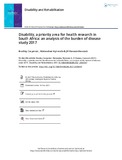| dc.contributor.author | Carpenter, Bradley | |
| dc.contributor.author | Nyirenda, Makandwe | |
| dc.contributor.author | Hanass-Hancock, Jill | |
| dc.date.accessioned | 2022-03-28T14:46:59Z | |
| dc.date.available | 2022-03-28T14:46:59Z | |
| dc.date.issued | 2021-10-25 | |
| dc.identifier.citation | Carpenter, B.; Nyirenda, M. and Hanass-Hancock, J. (2021) 'Disability, a Priority Area for Health Research in South Africa: an Analysis of the Burden of Disease Study 2017', Disability and Rehabilitation, DOI: 10.1080/09638288.2021.2000047 | en |
| dc.identifier.uri | https://opendocs.ids.ac.uk/opendocs/handle/20.500.12413/17262 | |
| dc.description.abstract | Purpose: Disabilities are increasing globally, which is attributed to the overall ageing of populations in affluent countries. This trend may differ in low and middle-income countries. This paper assesses the change over time in Years Lived with Disability (YLD) for South Africa and how this compares to regional and global trends. Materials and methods: This secondary analysis of the Global Burden of Disease Study 2017 dataset describes the observed contribution of YLD to Disability-Adjusted Life Years (DALYs) per 100 000 people over the period 1990–2016, and forecast to 2030 using simple linear prediction. South African trends are compared to global and sub-Saharan African (SSA) trends to highlight the effect of HIV and policy implications. Results:
Globally, the contribution of YLD to DALYs has increased from ±21.7% in 1990 to ±34% by 2016, with high socio-demographic index countries having a higher contribution (49%). HIV, mental health, musculoskeletal, neurological, and sense organ disorders are the five main contributors to YLD in South Africa (54%). Removing the effects of HIV/AIDS and sexually transmitted infections on YLD, South Africa’s trend appears similar to the global trend, yet opposite to the SSA trend. Conclusion: Our analysis shows there is a growing burden of disability in South Africa. Differences in trends with the regional and global patterns can be attributed to the high burden of HIV and non-communicable diseases in South Africa. Therefore, strategies are urgently needed to increase integration of disability and rehabilitation services into chronic HIV and non-communicable disease management. This calls for disability screening to identify functional limitations in routine data collection and case management. | en |
| dc.language.iso | en | en |
| dc.publisher | Taylor & Francis Group | en |
| dc.rights.uri | http://creativecommons.org/licenses/by-nc-nd/4.0/ | en |
| dc.subject | Health | en |
| dc.title | Disability, a Priority Area for Health Research in South Africa: an Analysis of the Burden of Disease Study 2017 | en |
| dc.type | Article | en |
| dc.rights.holder | 2021 The Author(s). Published by Informa UK Limited, trading as Taylor & Francis Group. | en |
| dc.identifier.externaluri | https://www.tandfonline.com/doi/full/10.1080/09638288.2021.2000047 | en |
| dc.identifier.doi | 10.1080/09638288.2021.2000047 | |
| rioxxterms.funder | Default funder | en |
| rioxxterms.identifier.project | Default project | en |
| rioxxterms.version | NA | en |
| rioxxterms.versionofrecord | 10.1080/09638288.2021.2000047 | en |
| rioxxterms.funder.project | 9ce4e4dc-26e9-4d78-96e9-15e4dcac0642 | en |


